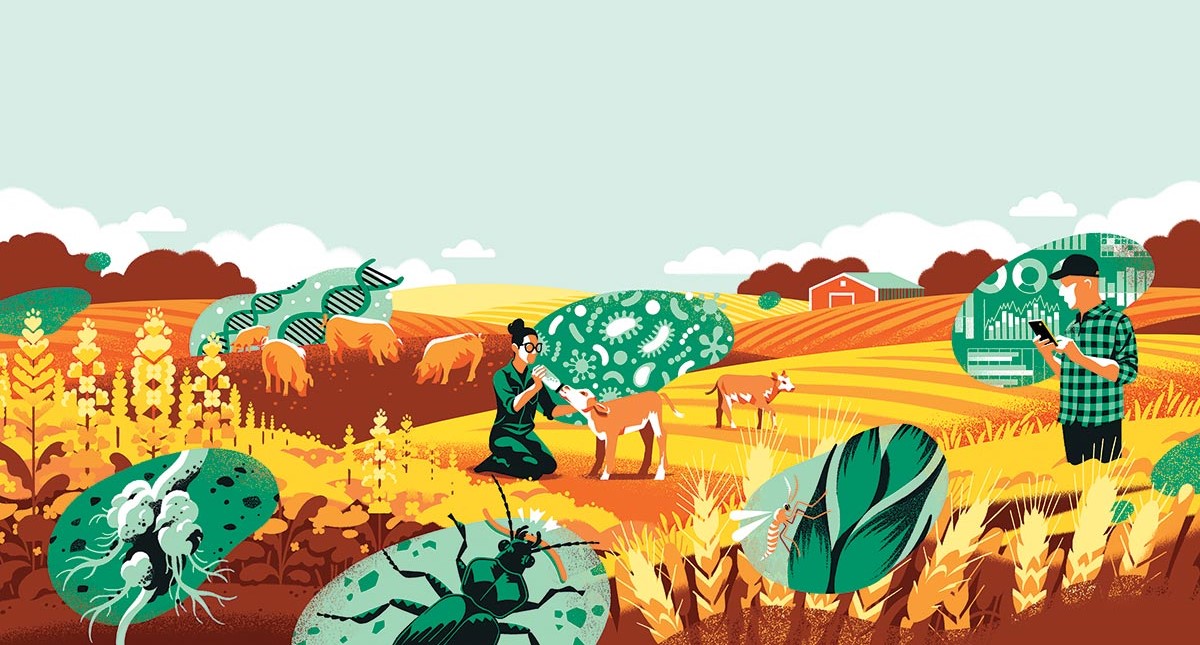When it comes to agriculture, tiny things can create havoc: insects, bacteria, a few degrees of temperature change. Fortunately, tiny things can also be the source of solutions. Here are some of the ways researchers in the Faculty of Agricultural, Life & Environmental Sciences and others are solving problems that could threaten our food supply and our climate.
Problem: Canola-killing parasite
Solution: Plant DNA
Clubroot is a nasty, soil-borne disease that attacks the roots of a canola plant. Even nastier, the parasite that causes it — first identified in Alberta in 2003 — has mutated into 36 known strains, many of which aren’t stopped by the clubroot-resistant seed used since 2010. Plant pathologist Stephen Strelkov, ’93 BSc, is digging through plant DNA to find new sources of pathogen resistance that can be bred into canola seeds. “We’re confident we are going to find some good solutions.”
Problem: Bugs
Solution: Bug brigade
In this bug-eat-bug world, researchers wonder if there’s a bigger role for natural pest control in farm fields. Entomologist Boyd Mori, ’07 BSc(Spec), ’09 BSc(Spec), ’14 PhD, and a team of grad students are looking at the ground beetle as one possible ally. “We can dissect the gut and use next-generation DNA sequencing to figure out what the insect has been eating,” Mori explains. “We’re hoping to find that they are feeding on our pest species. That tells us which are the most important species to work on conserving.” The hope is a bug brigade of natural crop protectors could help farmers reduce the use of chemical pesticides.
Problem: Underdeveloped gut bacteria
Solution: Probiotics for calves
Newborn dairy calves’ undeveloped immune systems leave them susceptible to common ailments like diarrhea that can stunt growth, reduce productivity and increase costs for producers. But a study by student researcher Maddison Degenshein found that calves fed a probiotic with four gut bacteria from healthy cows were healthier in the crucial first weeks of life. The research also helped determine that calves are most vulnerable to illness in the first six to nine weeks of life.
Problem: Greenhouse gases
Solution: Carbon storage
Prairie ranchland has a value beyond grazing cattle: it stores carbon. Maintaining grasslands “helps keep carbon in the ground and not in the atmosphere,” says grasslands ecology researcher Cameron Carlyle. He’s co-leading a project to map out carbon storage values of about eight million hectares of perennial prairie grassland across Saskatchewan. The map will be available to producers across the Prairie provinces to help manage their fields, and the resulting database will support further research.
Problem: Hog diseases
Solution: Animal genomics
Sickly swine pose a double-headed challenge: a financial cost and a loss of public trust around animal safety and antibiotic use. An eight-year Genome Alberta project has pinpointed key traits of healthy hogs and is working toward incorporating those into breeding programs. Michael Dyck, a U of A expert in reproductive technologies, explains: “Producers will know that the pigs they market come from an optimal health environment — and that knowledge can be passed along to consumers.”
Problem: Wheat midges
Solution: Plant genomics and metabolomics
The tiny wheat midge causes about $60 million in damage a year in Western Canada. There’s concern the orange flies will become resistant to the sole existing defence. But the female midges have a quirk: they won’t lay eggs in wheat that has a bad smell. So researchers in the Faculty of Science and ALES are sniffing out ways to create a strain that will repel the midges. Says chemistry researcher James Harynuk: “This is the sort of thing that could be a really big game-changer for the wheat industry.”
Problem: Data and more data
Solution: Artificial intelligence
An “armchair rancher” app that uses machine learning promises to make farming and ranching more efficient, economical and sustainable. The joint project of agriculture and science researchers will leverage data such as historic weather patterns, market projections, herd genetics and economics. “As business owners, their profit depends on decisions,” says science researcher David Wishart, ’83 BSc(Hons). “We want to give them a digital assistant that helps them make smart moves.”

We at New Trail welcome your comments. Robust debate and criticism are encouraged, provided it is respectful. We reserve the right to reject comments, images or links that attack ethnicity, nationality, religion, gender or sexual orientation; that include offensive language, threats, spam; are fraudulent or defamatory; infringe on copyright or trademarks; and that just generally aren’t very nice. Discussion is monitored and violation of these guidelines will result in comments being disabled.